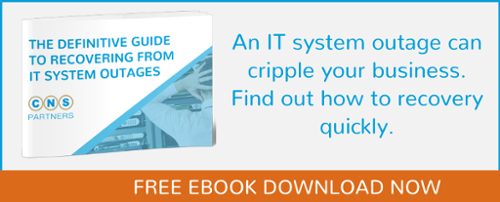How to Engineer IT Systems for Rapid Recovery in Case of Natural Disaster

From 1980 to the present, the United States has seen 265 weather- and climate-related disasters that each resulted in more than a billion dollars’ worth of damage. These included severe hailstorms and tornadoes, wildfires and hurricanes, widespread river flooding, winter storms and freeze events. Billion-dollar disasters have occurred in all 50 states, costing businesses and homeowners a total of more than $2 trillion over the past few decades.
According to the National Oceanic and Atmospheric Administration (NOAA), these major disaster events are occurring more frequently than ever before, and their costs are increasing as well. Growing numbers of businesses and homes are being built in places that are vulnerable to flooding, while climate change is increasing the intensity and frequency of major storms.
Though your business’s individual risks are mostly determined by your geographical location, it’s likely that they’re on the rise.
Meanwhile, the potential losses that a natural disaster could cause your business are greater than ever before. Whether your firm is large or small, it’s probably becoming more and more dependent on IT systems that are essential for maintaining critical operations, and the per-minute costs of unplanned downtime and data center outages continue to grow for organizations across all industries. Data from the Federal Emergency Management Agency (FEMA) indicates that as many as 60 percent of small to mid-sized businesses will never again open their doors after a fire, flood or major natural disaster, and among those that do, fewer than one-third will survive the next two years.

Do you want to position your business to be among this resilient minority? Would you like to maximize your chances of emerging unscathed from the worst-case scenario?
When it comes to readying your organization to survive a natural disaster, comprehensive business continuity and disaster recovery planning is the key. From comparing policies and purchasing adequate insurance coverage to building IT systems that will protect your data no matter what happens to the hardware in your office buildings and facilities, the steps you take to prepare will make all the difference. The better you plan, the faster you’ll be able to recover, and the less data loss you’ll suffer. That means you’ll be better able to get back on your feet again quickly, and you’ll minimize your financial losses as a result.
Here are the four most important concepts to keep in mind as you embark upon natural disaster recovery planning for your manufacturing or supply chain business:
#1: How you recover depends on the type of natural disaster you experience: study your real-life risks and estimate the probability of their occurrence.
The steps you’d need to take to recover from a flood are different than those you’d follow in case of fire; recovering from an earthquake isn’t like repairing ice damage caused by a winter storm. Some types of natural disasters will require complete and immediate replacement of all on-site hardware, while others may damage only some network components, leaving others intact. Insurance coverage may vary depending on the exact nature of the event as well.
Begin by assessing which natural disasters you’re most vulnerable to. This involves understanding what’s likely in your region as well as local area. (Is your building located in an earthquake zone? A 50- or 100-year floodplain? Does your part of the country have severe winter storms? How often do tornadoes occur?) You should also take structural considerations into account. (Has your building been engineered to withstand earthquakes? To tolerate gale-force winds? Does your building have a fire suppression system? Is most IT equipment located on the ground floor?)
An essential component of the risk-assessment phase is analyzing the impact that any possible disaster scenario could have on the business. If there are steps you can take to mitigate hazards, or lessen the financials risks you’d face in case of disaster (such as purchasing flood insurance), you should consider them during this stage.
#2: Move your data (which is invaluable and irreplaceable) outside of your building.
 The most important thing you can do to make your IT systems more resilient in the face of natural disaster is to store your data offsite. Whether you choose public cloud storage for your backups or you go with a private cloud computing solution, you’ll be able to get back in business more quickly in the wake of any emergency if your data is secured within an offsite data center.
The most important thing you can do to make your IT systems more resilient in the face of natural disaster is to store your data offsite. Whether you choose public cloud storage for your backups or you go with a private cloud computing solution, you’ll be able to get back in business more quickly in the wake of any emergency if your data is secured within an offsite data center.
Desktop and laptop computers, workstations and networking equipment are readily replaceable. Most often, their costs are covered by insurance. And off-the-shelf hardware devices can be ordered, set up and configured more quickly than carpenters and electricians can repair structural damage to the building. But lost data is gone forever, and companies that suffer significant data loss are far more likely to go out of business than those that experience only hardware loss.
Many different cloud-based solutions are available today, ranging from simple storage volumes for backups and snapshots to comprehensive Business Continuity and Disaster Recovery-as-a-Service (BCDRaaS) offerings. Finding and investing in the one that’s best for your budget and business needs may enable your organization to survive a future catastrophe.
#3: Minimize data loss by determining your Recovery Point Objective (RPO) carefully.
 Often discussed in tandem with Recovery Time Objective (RTO), which designates how long it’d take to restore all your data from backups, Recovery Point Objective (RPO) indicates how often backups are completed, and thus, the maximum amount of data you might lose if you had to restore from one. RPOs can range from 24 hours to a few seconds—a great deal of variability. You’ll need to invest more to have shorter RPO times, which may make sense for certain business-critical applications. For others, 24 hours’ worth of data loss may be an acceptable risk. This should be evaluated on an application-by-application basis, taking into account how often particular software is typically used and what impact it has on your ability to maintain your operations.
Often discussed in tandem with Recovery Time Objective (RTO), which designates how long it’d take to restore all your data from backups, Recovery Point Objective (RPO) indicates how often backups are completed, and thus, the maximum amount of data you might lose if you had to restore from one. RPOs can range from 24 hours to a few seconds—a great deal of variability. You’ll need to invest more to have shorter RPO times, which may make sense for certain business-critical applications. For others, 24 hours’ worth of data loss may be an acceptable risk. This should be evaluated on an application-by-application basis, taking into account how often particular software is typically used and what impact it has on your ability to maintain your operations.
#4: Develop strategies to enable you to set up new hardware systems quickly.
In most cases, how much money your business loses in a natural disaster is a function of how long your operations are shuttered. That’s why it makes sense to partner with an IT service provider with extensive experience procuring hardware for companies in your industry. A professional with this experience will know where to obtain the equipment you need as quickly as possible and for the best price. They’ll also be able to assist with deploying and configuring your new hardware, and can help ensure that restoring from backups goes smoothly and efficiently.
To facilitate this process, be sure that you’re storing all essential system configuration settings in an offsite location. A cloud storage solution often makes the most sense for this purpose as well.
Natural disasters can and do occur, but they don’t have to take your business offline for long. Want to learn more about how you can build resilient systems to mitigate this risk? Check out our latest eBook, “The Definitive Guide to Recovering from IT System Outages” today.



